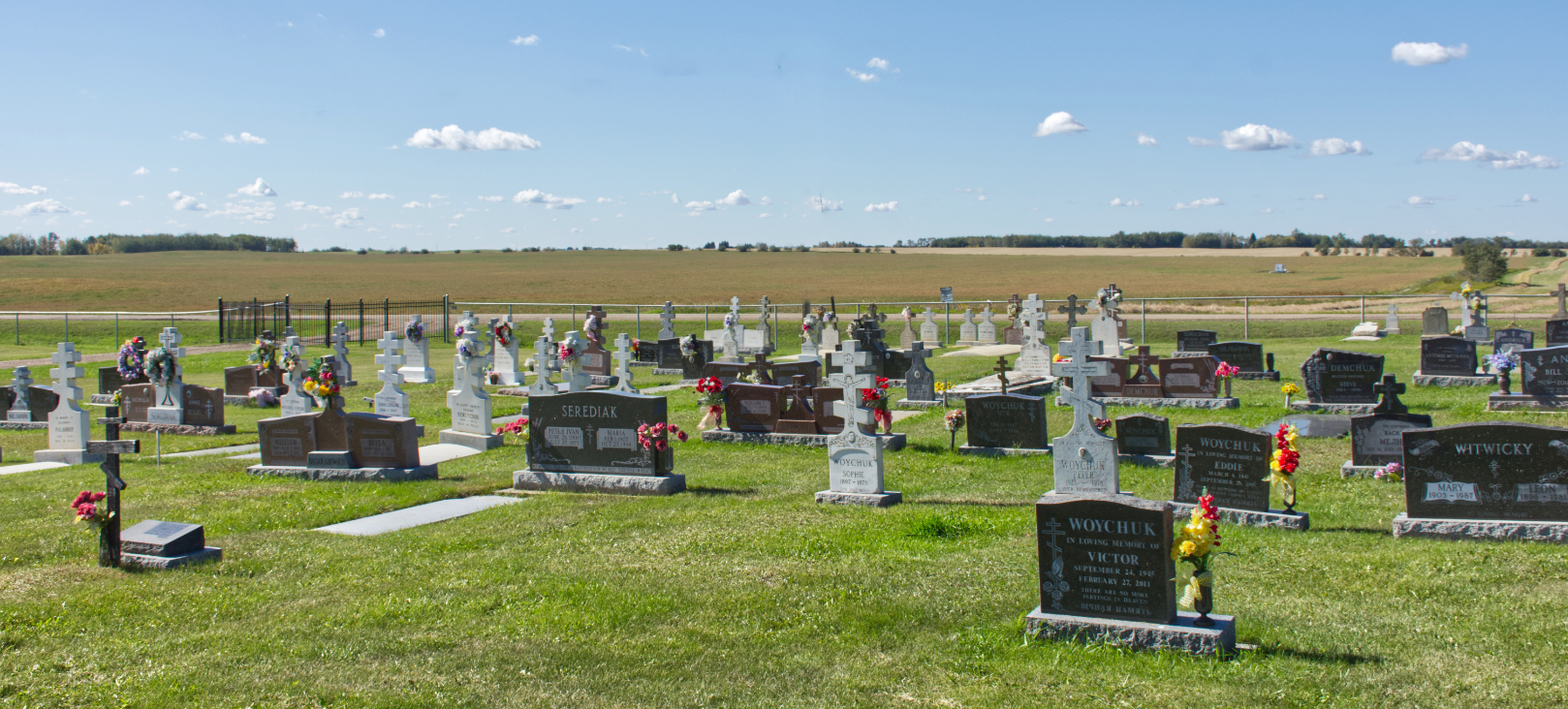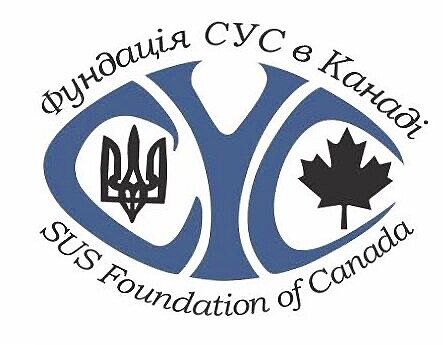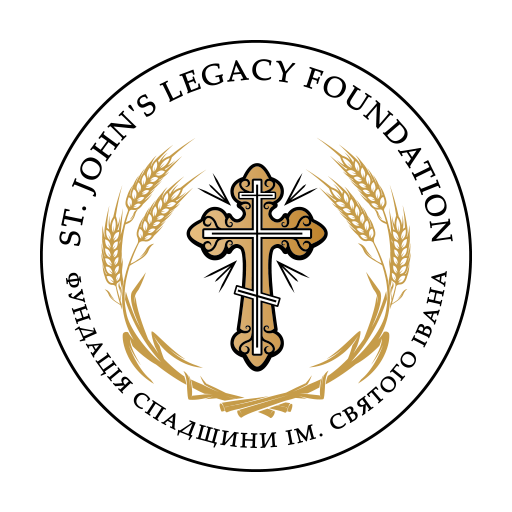T
he origins of the Holy Trinity Ukrainian Orthodox congregation can be traced back to a conflict that arose in the second half of the 1920s within the Russian Greek Orthodox Church of Holy Trinity at nearby Sunland. The latter had been established in 1912, when ten acres of land were purchased for a church and cemetery at NW 1-58-16 W4. Among those who worked on the construction of Holy Trinity Russian Orthodox church was Ivan (John) Mnoholitny. He was a local farmer and skilled carpenter who in 1920 was commissioned to build a hall and bell-tower for the sum of $350, and in 1922 was elected as the congregation's secretary.
However, in 1927-1928, a significant number of Sunland adherents decided that they wanted to join the Ukrainian Greek Orthodox Church of Canada. The UGOC was increasingly successful in attracting nationally conscious Orthodox believers who were feeling uncomfortable about being part of a pro-Russian formation. This move divided the Bukovynian and Galician farmers who had homesteaded the area north of Andrew in the early years of the century. Tthe dissension eventually precipitated legal action over the ownership and affiliation of the Sunland church. When the court eventually ruled in favour of those still loyal to Russian Orthodoxy, the pro-Ukrainian group responded by forming in 1929 a Brotherhood comprised of the more nationally aware farmers in the Kahwin district. It appears that the majority of the Holy Trinity congregation sided with the break-away group, as membership in the Sunland church is reported to have fallen to eighteen by 1928, compared to eighty-seven in 1920.
The first goal of the Ukrainian Brotherhood was to erect a place of worship; until that was accomplished, services took place in the homes of area residents and in rented community halls. Then, in 1931 several acres of land were purchased for a cemetery and church just one and a half miles southwest of Holy Trinity at Sunland. Interestingly, the graveyard had been previously established by the Presbyterian-backed Independent Church, which in the teens had an active congregation in the Kahwin district. There was also an Independent grouping in nearby Sniatyn, while the pastor was based in the village of Andrew.
At the time of the original land acquisition, the Holy Trinity Ukrainian Orthodox congregation consisted of twenty paid family members, numbering a total of ninety-eight individuals. One of the founders of the church was the twenty-year-old Ivan (John) Decore. Decore in 1949 and 1953 was elected as a Liberal to federal parliament for Vegreville constituency, and from 1965 to 1979 served as the Chief Judge of the District Court of Northern Alberta. (Justice Decore was also the father of the late Edmonton mayor and provincial Liberal leader, Laurence Decore). Construction of the Holy Trinity Ukrainian Orthodox Church began on 7 June 1932 under the direction of John (Ivan) Mnoholitny. It proceeded so quickly that the exterior was completed by 26 July of the same year. On 21 August 1932 [another source says September] Archbishop Ioan Theodorovich blessed the new church during a visitation that he made to the community.
Tragically, this structure was destroyed the following year by a mysterious fire, necessitating that the fledgling parish start all over again. Undaunted by the setback, members began work on a new place of worship on 21 July 1934, with Ivan Mnoholitney once more overseeing the endeavour. The second Holy Trinity church was a cruciform structure topped by a central dome, with two cupolas on towers that flanked the facade. Its original exterior walls were covered with clapboard. Mnoholitny, who was responsible for building some nineteen churches, was apparently buried after his death in 1962 in Evergreen Cemetery. In 1938 a church choir was established on the initiative of N. Melnyk, who served as its conductor for many years. The choir often sang at services in neighbouring churches, including Andrew, Sachava, and Zawale.
In 1947 and 1948 the Kahwin congregation had eleven registered family members, and reported celebrating five liturgies in the course of the second of these years. In a letter to the Consistory in April 1950, the church secretary complained that not only had no services taken place at Holy Trinity during the Lenten period, but the priest had failed to show up to perform the ritual blessing of the Easter baskets at midnight as promised. Consequently, some parishioners had gone to have their baskets sprinkled by a Russian Orthodox batiushka, while others simply ate their Easter meal without having it properly sanctified. The secretary further expressed concern that the Jehovah's Witness movement and an unspecified "holy roller" sect was starting to make inroads into the local community.
Notwithstanding these problems, in 1951 membership in the congregation grew to fourteen, and it increased by another two families the following year, when a total of eleven services were hosted at Holy Trinity. In 1955, seven liturgies and three feast day commemorations were held in the sanctuary, which by then counted twenty-two paid members and approximately fifteen sympathizers. An article submitted to Winnipeg for publication in the mid-1950s claimed that there were roughly seventy Orthodox families in the vicinity of the Kahwin sanctuary. There was obviously still potential for additional growth, even though the general rural population was gradually declining.
As the 1950s drew to a close the church was hosting eight to ten services annually, and its membership remained constant at nineteen. Unfortunately, a shortage of priests meant that Kahwin (like other small congregations) was only able to arrange for religious services on an occasional basis, and not always at the times preferred by parishioners. Thus, when the Willingdon-based priest was unable to celebrate the annual feast day with the community in 1960, a letter of concern was sent to the Consistory noting that some members were so offended that they had started engaging the Russian cleric who served at Sunland for weddings and baptisms. The hurt feelings quickly dissipated, however, when a new pastor, Ihumen Alexander Shcherban, was assigned to the congregation.
Under Father Shcherban's care, the congregation enjoyed several harmonious and productive years. In 1965 the congregation legally incorporated itself, further consolidating its existence. Nonetheless, the passage of time inevitably sapped the vitality of the congregation, which like other rural parishes was confronted with a slowly shrinking and aging membership. This situation was further exacerbated by the sporadic services which the dwindling congregation received from the overextended priests assigned to look after the Holy Trinity faithful. Although in 1981 the church still reported having a total of thirty individual members, only a half-dozen of these were said to be active. By 1994, just six families remained, and it was becoming increasingly difficult to carry on because all of the members were in their seventies and eighties. Like so many other churches in the Alberta countryside, Holy Trinity seems to have almost no chance of long-term survival.
Over the course of its history, Holy Trinity at Kahwin was renovated several times: during Andrew Andriuk's leadership of the congregation, a basement was dug under the church, the exterior siding was stuccoed, and new asphalt shingles were put on the roof. At some point a storm porch was also added, further refining the appearance of the church. In 1960 the interior was thoroughly remodeled, and a new ikonostasis, made by William Sawchuk of Edmonton, was installed. The outside of the church was also painted at this time, and the roof was reshingled. On 20 August 1972, Archibishop Andrew helped to celebrate the fortieth anniversary of the Kahwin Church.
See HERE for more information and a detailed history of this parish.
Cemetery
The cemetery is located on the same parcel of land as the church. The first burials date as far back as 1910. Among the early interments were the resting-places of two children in a family that later moved to Edmonton and joined the pro-Communist wing of the Ukrainian community. The graves of these two children were to become a source of considerable controversy when in 1947 family members decided to erect monuments on them that were not deemed to be of a Christian character. The members of Holy Trinity Church opposed the installation of secular markers on consecrated ground, insisting that graves had to be marked with crosses. Unsure if they could forbid the placing of the markers, the church executive wrote to Winnipeg for guidance in the matter. The Consistory cautiously advised the congregation to seek legal advice as to whether or not they had the right to prohibit the erection of the "Communist" memorials, which the patriotically-Ukrainian parishioners viewed as politically offensive. It is not known how this conflict was ultimately resolved.

Play Memory Eternal Chant
Visit this Cemetery
GPS Co-ordinates: 53.983992, -112.281533
Affiliation: Ukrainian Orthodox Church of Canada



 Financial support generously provided by:
Financial support generously provided by: 